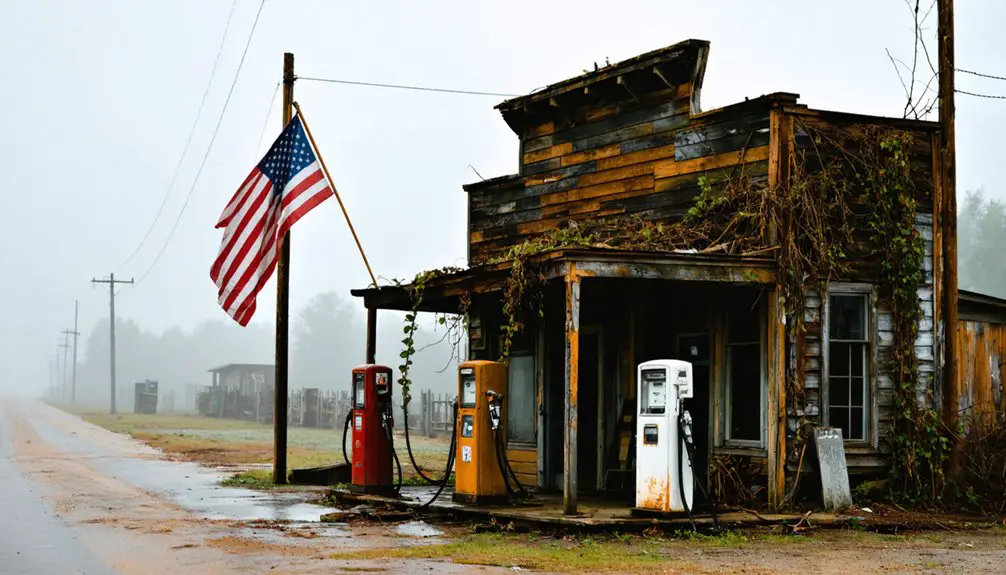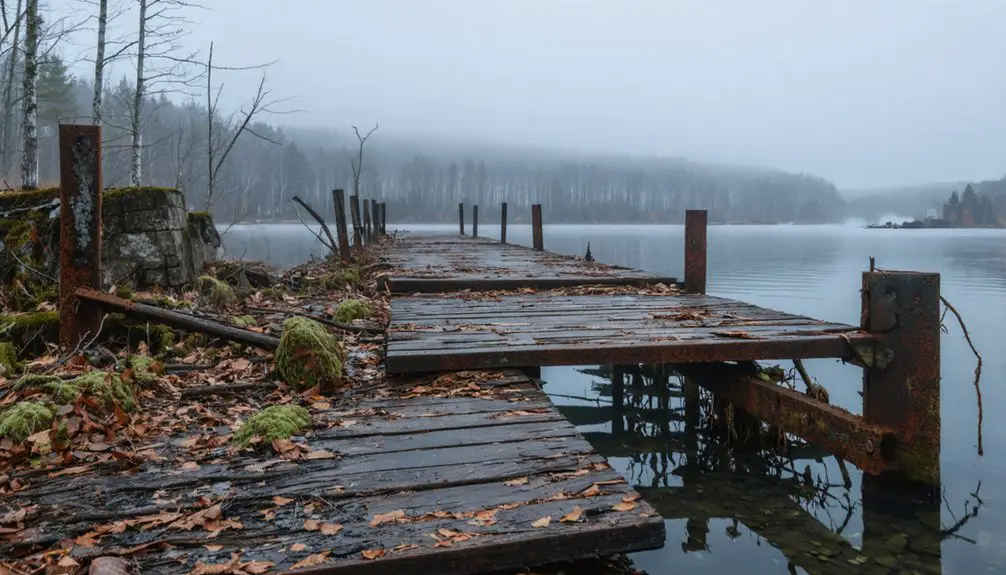You’ll find Doanesburgh’s ghost town remnants in Putnam County, New York, where this rural settlement thrived briefly from 1839 to 1855. The community, established around a post office by Benjamin Doane, served as a crucial communication hub for the region’s 2,079 residents. Today, you can explore stone foundations, fallen walls, and a weathered cemetery with original gravestones. The town’s abandoned grounds hold countless untold stories of 19th-century rural life.
Key Takeaways
- Doanesburgh, established in 1839, became a ghost town by 1855 after just 16 years of existence in rural New York.
- The abandoned settlement contains stone foundations, fallen walls, and a weathered cemetery with original gravestones from former residents.
- Benjamin Doane founded the community, which centered around a post office serving as a vital communication hub in Putnam County.
- Economic decline and limited employment opportunities led to population exodus, transforming the once-active settlement into an abandoned site.
- The ghost town features 643 historic structures, 55 cemeteries, and worn paths that trace the original layout of streets.
Early Settlement and Founding Years (1839)
Doanesburgh emerged as a distinct rural community in 1839 when its first post office opened in Southeast, Putnam County, New York. The settlement’s founding identity centered around Benjamin Doane, an early settler whose influence shaped the area’s development in the early 1800s. The hamlet was positioned strategically with respect to the cardinal directions, allowing efficient navigation and trade routes for settlers.
You’ll find that Doanesburgh‘s postal significance extended beyond mere mail delivery – it marked the hamlet as a crucial communication hub within the newly-established Putnam County, which had only separated from Dutchess County in 1812.
The post office served as a cornerstone of local infrastructure, enabling settlers to connect with broader markets and governance structures. While exact population figures aren’t known, the community typified the era’s rural settlements, with residents clustering around key amenities and engaging primarily in farming and local trade. By 1854, the broader Southeast area had grown to include 2,079 residents, reflecting the region’s steady development.
Life in a Rural New York Community
While many rural New York communities underwent dramatic changes in the 19th century, life in Doanesburgh centered primarily around dairy farming, with Pine Grove Farms standing as a symbol to the area’s agricultural heritage.
You’d find community dynamics shaped by English Quaker settlers from Dutchess County and Kent, Connecticut, who established deep roots across the region’s farmsteads and small hamlets.
Rural traditions flourished at major crossroads in four distinct communities: Delanson, Quaker Street, Mariaville, and Eatons Corners.
If you’d visited during the railroad era, you’d have witnessed Delanson’s transformation into a bustling railway hub, where coal piles towered over 100 feet high and wooden shops lined the streets. The village became home to the world’s largest coaling station by 1907.
The area’s 643 historic structures and 55 cemeteries still tell the story of these early settlers.
Today, the landscape features wooded hills rising to approximately 1,400 feet above sea level, creating a scenic backdrop for the historic community.
The Decline and Abandonment
Despite the promise of rural prosperity that marked many early New York settlements, the story of Doanesburgh took a darker turn in its brief 16-year existence from 1839 to 1855.
You’ll find that economic factors played a decisive role in the town’s demise. Like many ghost towns of the era, Doanesburgh’s fate was sealed by its dependence on a single industry or resource. Much like Parksville in Sullivan County, the town gradually succumbed to abandonment. The remaining visible structures today offer glimpses into the town’s past.
When the town’s primary economic engine faltered, residents faced dwindling employment opportunities. Population trends show a steady exodus as families sought better prospects elsewhere.
Without a diversified economy to sustain it, the community couldn’t adapt to changing times. The absence of key transportation routes may have further isolated the settlement, accelerating its decline until, by 1855, you’d have found little more than an empty shell of its former self.
Ghost Town Features and Remnants
As you explore the abandoned grounds of Doanesburgh today, the town’s physical remnants tell a compelling story of its brief existence. Urban exploration reveals stone foundations, fallen walls, and the skeletal remains of 19th-century structures now claimed by encroaching forest. The town’s legacy dates back to when Benjamin Doane established the settlement. Similar to Happy Valley abandoned, many residents were forced to relocate when the area was designated for preservation.
You’ll discover evidence of historical preservation through surviving architectural features and scattered artifacts that paint a picture of daily life in this once-thriving community.
- Stone chimneys and foundation walls stand as silent sentinels, marking where homes and businesses once thrived.
- A weathered cemetery contains original gravestones, providing genealogical links to former residents.
- Rusted metal fragments, broken ceramics, and glass shards litter the ground, offering glimpses into domestic life.
- Former roadways, now reduced to worn paths through meadows, trace the town’s original layout.
Historical Significance in New York State
Beyond the physical remnants that dot the landscape, Doanesburgh holds broader significance in New York State’s developmental narrative.
You’ll find it represents an essential piece in understanding how historical demographics shifted throughout the Hudson Valley during the 19th century. The town’s rise and decline mirror the economic shifts that swept through rural New York, as industrialization and changing transportation routes reshaped settlement patterns.
When you explore Doanesburgh’s story, you’re witnessing a microcosm of colonial and post-colonial development in the region. As part of Putnam County’s early formation, the settlement played a critical role in establishing communication networks through its post office, connecting remote areas to larger economic hubs.
Today, it stands as a reflection of the dynamic nature of rural community evolution in New York State.
Frequently Asked Questions
Where Did Benjamin Doane Come From Before Settling in Doanesburgh?
Like a puzzle missing its key piece, you can’t pinpoint where Benjamin Doane came from. Historical and genealogical records haven’t revealed his Doane ancestry or early migration path before settling there.
What Types of Crops or Livestock Were Primarily Raised in Doanesburgh?
You’ll find that wheat dominated as the primary crop variety, while dairy cattle were the main livestock breed, supported by the region’s fertile valleys and growing market demands.
Did Any Notable Crimes or Mysterious Events Occur in Doanesburgh?
You won’t find any documented unsolved mysteries or local legends in this settlement’s history. Historical records don’t show any notable crimes or unexplained events during its brief 16-year existence.
Are There Any Descendants of Original Doanesburgh Settlers Still Living Nearby?
After 168 years, you won’t find confirmed descendant stories from Doanesburgh’s settlers. While some family connections might exist in Putnam County today, there’s no documented proof of direct lineage nearby.
What Was the Maximum Population Ever Recorded in Doanesburgh?
You won’t find any officially recorded maximum population for Doanesburgh, though historical significance suggests population growth likely peaked under 500 residents during the town’s most active period in the 1800s.
References
- https://943litefm.com/abandoned-ghost-towns-new-york/
- https://www.duanesburg.net/town-historian/pages/history-duanesburg
- https://hudsonvalleypost.com/new-york-state-is-home-to-nearly-20-ghost-towns/
- https://lite987.com/11-ghost-towns-new-york-state/
- https://en.wikipedia.org/wiki/Category:Ghost_towns_in_New_York_(state)
- https://en.wikipedia.org/wiki/Doanesburgh
- https://en.wikipedia-on-ipfs.org/wiki/Doanesburgh
- https://greenerpasture.com/Places/Details/1398
- https://en.wikipedia.org/wiki/Southeast
- https://localhistories.org/a-history-of-new-york-city/



